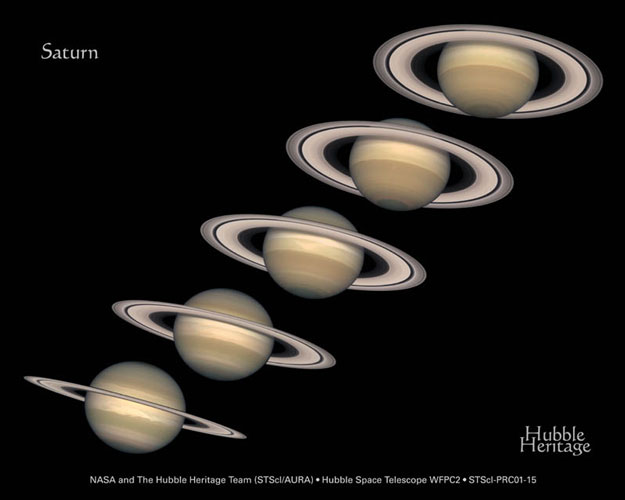Astronomy Picture of the Day
Discover the cosmos! Each day a different image or photograph of our fascinating universe is featured, along with a brief explanation written by a professional astronomer.
Posted on 08/16/2003 10:38:43 PM PDT by petuniasevan
Discover the cosmos! Each day a different image or photograph of our fascinating universe is featured, along with a brief explanation written by a professional astronomer.
Explanation: What could you see approaching Saturn aboard an interplanetary cruise ship? Your view would likely resemble this subtly shaded image of the gorgeous ringed gas giant. Processed by the Hubble Heritage project, the picture intentionally avoids overemphasizing color contrasts and presents a natural looking Saturn with cloud bands, storms, nearly edge-on rings, and the small round shadow of the moon Enceladus near the center of the planet's disk. Of course, seats were not available on the only ship currently en route, the Cassini spacecraft. Cassini flew by Jupiter at the turn of the millennium and is scheduled to arrive at Saturn in the year 2004. After an extended cruise to a world 1,400 million kilometers from the Sun, Cassini will tour the Saturnian system, conducting a remote, robotic exploration with software and instruments designed by denizens of planet Earth.
NASA's Hubble Space Telescope has provided images of Saturn in many colors, from black-and-white, to orange, to blue, green, and red. But in this picture, image processing specialists have worked to provide a crisp, extremely accurate view of Saturn, which highlights the planet's pastel colors. Bands of subtle color - yellows, browns, grays - distinguish differences in the clouds over Saturn, the second largest planet in the solar system.Saturn's high-altitude clouds are made of colorless ammonia ice. Above these clouds is a layer of haze or smog, produced when ultraviolet light from the sun shines on methane gas. The smog contributes to the planet's subtle color variations. One of Saturn's moons, Enceladus, is seen casting a shadow on the giant planet as it passes just above the ring system.
The flattened disk swirling around Saturn is the planet's most recognizable feature, and this image displays it in sharp detail. This is the planet's ring system, consisting mostly of chunks of water ice. Although it appears as if the disk is composed of only a few rings, it actually consists of tens of thousands of thin "ringlets." This picture also shows the two classic divisions in the ring system. The narrow Encke Gap is nearest to the disk's outer edge; the Cassini division, is the wide gap near the center.
Scientists study Saturn and its ring system to gain insight into the birth of our solar system.
Image Credit: NASA and The Hubble Heritage Team (STScI/AURA) Acknowledgment: R. G. French (Wellesley College)
Remember this image from April?


Disclaimer: Opinions posted on Free Republic are those of the individual posters and do not necessarily represent the opinion of Free Republic or its management. All materials posted herein are protected by copyright law and the exemption for fair use of copyrighted works.